Simulation of Parameters of Plasma Dynamics of a Magneto Plasma Compressor
Abstract
1. Introduction
2. Model of the MPC Discharge and Numerical Solution Method
3. Electrical Parameters and Power Regimes for Discharge
4. Plasma Dynamic Parameters for Discharge in Magneto Plasma Compressor
5. Comparison of the Results of Calculations of MPC Discharges in Gases with Experimental Data
6. Conclusions
- -
- the possibility of adding new force factors (in addition to the forces of inertia and magnetic field) to increase the efficiency of the magneto plasma compressor;
- -
- establishing the dependence of the main parameters of plasma flows (density, plasma temperature, velocity, energy content) on pressure, type of working gas, and discharge energy;
- -
- optimization of the MPC design and its power supply system in order to reduce its weight and dimensions and increase efficiency.
Author Contributions
Funding
Institutional Review Board Statement
Informed Consent Statement
Data Availability Statement
Conflicts of Interest
References
- Raizer, Y.P. Gas Discharge Physics; Springer: Berlin, Germany, 1991. [Google Scholar]
- Stewardson, H.R.; Novac, B.M.; Miran, S.M.; Smith, I.R.; Enache, M.C. A two-stage exploding-foil/plasma erosion opening switch conditioning system. J. Phys. D Appl. Phys. 1997, 30, 1011. [Google Scholar] [CrossRef]
- Giovannini, A.Z.; Barendregt, I.; Haslinde, T.; Hubbs, C.; Abhari, R.S. Self-confined plasma in a magneto-plasma compressor and the influence of an externally imposed magnetic field. Plasma Sources Sci. Technol. 2015, 24, 025007. [Google Scholar] [CrossRef]
- Brovkin, V.G.; Klimov, A.I.; Mashek, I.C.; Pashchina, A.S.; Ryzazansky, N.M.; Vedenin, P.V. Initiation of the plasma jet of the magneto-plasma compressor by the external plasma source. J. Phys. Conf. Ser. 2021, 2100, 012005. [Google Scholar] [CrossRef]
- Zel’dovich, Y.B.; Raizer, Y.P. Physics of Shock Waves and High-Temperature Hydrodynamic Phenomena; Dover: Mineola, NY, USA, 2002. [Google Scholar]
- Garkusha, I.E.; Chebotarev, V.V.; Herashchenko, S.S.; Makhlaj, V.A.; Kulik, N.V.; Ladygina, M.S.; Marchenko, A.K.; Petrov, Y.V.; Staltsov, V.V.; Shevchuk, P.V.; et al. Novel test-bed facility for PSI issues in fusion reactor conditions on the base of next generation QSPA plasma accelerator. Nucl. Fusion 2017, 57, 116011. [Google Scholar] [CrossRef]
- Grishin, Y.M.; Kozlov, N.P.; Kuzenov, V.V. Singularities of spectral-brightness characteristics of pulsed radiating surface discharges in dense gases. High Temp. 1998, 36, 169–175. [Google Scholar]
- Göksel, B.; Mashek, I.C. First Breakthrough for Future Air-Breathing Magneto-Plasma Propulsion Systems. J. Phys. Conf. Ser. 2017, 825, 012005. [Google Scholar] [CrossRef]
- Kamrukov, A.S.; Kashnikov, G.N.; Kozlov, N.P.; Kondratenko, M.M.; Lebedev, E.F.; Orlov, V.K.; Ostashev, V.E.; Protasov, Y.S.; Semenov, A.M. Experimental investigation of the effectiveness of the matching of a magneto plasma compressor with an explosive magnetohydrodynamic generator. High Temp. 1984, 22, 313–318. [Google Scholar]
- Kuzenov, V.V.; Ryzhkov, S.V. Numerical Simulation of Pulsed Jets of a High-Current Pulsed Surface Discharge. Comput. Therm. Sci. 2021, 13, 45–56. [Google Scholar] [CrossRef]
- Kozlov, A.N. Study of MHD dynamo effect at the outlet from plasma accelerator in the presence of longitudinal magnetic field. Contrib. Plasma Phys. 2020, 60, e201900174. [Google Scholar] [CrossRef]
- Kuzenov, V.V.; Ryzhkov, S.V. The Qualitative and Quantitative Study of Radiation Sources with a Model Configuration of the Electrode System. Symmetry 2021, 13, 927. [Google Scholar] [CrossRef]
- Astashynski, V.M.; Dzahnidze, H.M.; Kostyukevich, E.A.; Kuzmitski, A.M.; Shoronov, P.N.; Shymanski, V.I.; Uglov, V.V. Generation of erosion compression plasma flows in a miniature plasma accelerator and their capability for formation of thin nanostructured coating. High Temp. Mater. Process. 2020, 24, 99–107. [Google Scholar] [CrossRef]
- Kuzenov, V.V.; Ryzhkov, S.V.; Varaksin, A.Y. The Adaptive Composite Block-Structured Grid Calculation of the Gas-Dynamic Characteristics of an Aircraft Moving in a Gas Environment. Mathematics 2022, 10, 2130. [Google Scholar] [CrossRef]
- Kamrukov, A.S.; Kozlov, N.P.; Protasov, Y.S.; Chuvashev, S.N.; Shchepanyuk, T.S. On the influence of hydrodynamic instabilities on the spectral-brightness characteristics of radiating discharges. Tech. Phys. 1987, 57, 1412–1416. [Google Scholar]
- Kamrukov, A.S.; Kozlov, N.P.; Malashchenko, V.A.; Protasov, Y.S. Formation of a plasma focus in a plasma erosion accelerator. III—Radiation properties of the dense plasma focus. Sov. Phys. Tech. Phys. 1977, 22, 967–974. [Google Scholar]
- Vedenov, A.A.; Gladush, G.G. Physical Processes in Laser Processing of Materials; Energoatomizdat: Moscow, Russia, 1985. [Google Scholar]
- Varaksin, A.Y.; Ryzhkov, S.V. Vortex Flows with Particles and Droplets (A Review). Symmetry 2022, 14, 2016. [Google Scholar] [CrossRef]
- Kuzenov, V.V.; Ryzhkov, S.V.; Varaksin, A.Y. Numerical Modeling of Individual Plasma Dynamic Characteristics of a Light-Erosion MPC Discharge in Gases. Appl. Sci. 2022, 12, 3610. [Google Scholar] [CrossRef]
- Varaksin, A.Y.; Ryzhkov, S.V. Particle-Laden and Droplet-Laden Two-Phase Flows Past Bodies (A Review). Symmetry 2023, 15, 388. [Google Scholar] [CrossRef]
- Varaksin, A.Y.; Ryzhkov, S.V. Turbulence in Two-Phase Flows with Macro-, Micro- and Nanoparticles: A Review. Symmetry 2022, 14, 2433. [Google Scholar] [CrossRef]
- Kuzenov, V.V.; Ryzhkov, S.V.; Varaksin, A.Y. Calculation of heat transfer and drag coefficients for aircraft geometric models. Appl. Sci. 2022, 12, 11011. [Google Scholar] [CrossRef]
- Grishin, Y.M.; Kozlov, N.P.; Kuzenov, V.V. On the degradation of a shock wave in high-current radiating discharges in gases at atmospheric pressure. Tech. Phys. Lett. 1998, 24, 444–445. [Google Scholar] [CrossRef]
- Varaksin, A.Y.; Romash, M.E.; Kopeitsev, V.N. Controlling the behavior of air tornados. High Temp. 2009, 47, 836–842. [Google Scholar] [CrossRef]
- Varaksin, A.Y.; Romash, M.E.; Kopeitsev, V.N. Physical simulation of air tornados: Some dimensionless parameters. High Temp. 2011, 49, 310–313. [Google Scholar] [CrossRef]
- Dyachenko, V.F.; Imshennik, V.S. Two-dimensional magnetohydrodynamic model for the dense plasma focus of a Z pinch. In Reviews of Plasma Physics; Leontovich, M.A., Ed.; IOP Publishing: Bristol, UK, 1980; Volume 8, pp. 199–299. [Google Scholar]
- Kuzenov, V.V.; Ryzhkov, S.V. Estimation of the neutron generation in the combined magneto-inertial fusion scheme. Phys. Scripta 2021, 96, 125613. [Google Scholar] [CrossRef]
- Olson, G.L. Efficient solution of multi-dimensional flux-limited nonequilibrium radiation diffusion coupled to material conduction with second-order time discretization. J. Comput. Phys. 2007, 226, 1181. [Google Scholar] [CrossRef]
- Braginskii, S.I. Transport processes in plasma. In Reviews of Plasma Physics; Leontovich, M.A.I., Ed.; Consultants Bureau: New York, NY, USA, 1965. [Google Scholar]
- Surzhikov, S.T. Computing system for solving radiative gasdynamic problems of entry and re-entry space vehicles. In Proceedings of the 1st International Workshop on Radiation of High Temperature Gases in Atmospheric Entry, Lisbon, Portugal, 8–10 October 2003; Volume ESA-533. pp. 111–118. [Google Scholar]
- Kuzenov, V.V.; Ryzhkov, S.V.; Shumaev, V.V. Application of Thomas-Fermi model to evaluation of thermodynamic properties of magnetized plasma. Probl. At. Sci. Technol. 2015, 1, 97–99. [Google Scholar]
- Kuzenov, V.V.; Ryzhkov, S.V. Numerical modeling of laser target compression in an external magnetic field. Math. Model. Comput. Simul. 2018, 10, 255–264. [Google Scholar] [CrossRef]
- Volkov, K.N.; Emel’yanov, V.N. Modelirovanie Krupnykh Vikhrei v Raschetakh Turbulentnykh Techenii (Simulation of Large Eddies in the Calculations of Turbulent Flows); Fizmatlit: Moscow, Russia, 2008. (In Russian) [Google Scholar]
- Kuzenov, V.V.; Kotov, M.A. Analysis of gas dynamic processes and development of a flow model in a shock hypersonic wind tunnel. Vestn. Mosk. Gos. Tekh. Univ. N. E. Baumana Ser. Mashinostr. 2014, 1, 3–25. (In Russian) [Google Scholar]
- Kuzenov, V.V. Construction of regular adaptive grids in spatial domains with curved boundaries. Vestn. Mosk. Gos. Tekh. Univ. N. E. Baumana, Ser. Mashinostr. 2008, 1, 3–11. (In Russian) [Google Scholar]
- Chetverushkin, B.N. Mathematical Modeling of Problems in the Dynamics of a Radiating Gas; Nauka: Moscow, Russia, 1985. [Google Scholar]
- Kuzenov, V.V.; Ryzhkov, S.V. Approximate calculation of convective heat transfer near hypersonic aircraft surface. J. Enhanc. Heat Transf. 2018, 25, 181–193. [Google Scholar] [CrossRef]
- Molchanov, A.M. An effective numerical method for simulating chemically and thermally nonequilibrium gas flows. J. Phys. Conf. Ser. 2020, 1683, 022009. [Google Scholar] [CrossRef]
- Formalev, V.F.; Degtyarenko, R.A.; Garibyan, B.A.; Kolesnik, S.A. Modeling heat and mass transfer during periodical spraying of a high-temperature heat-resistant coating. High Temp. 2022, 60 (Suppl. 1), S76–S80. [Google Scholar] [CrossRef]
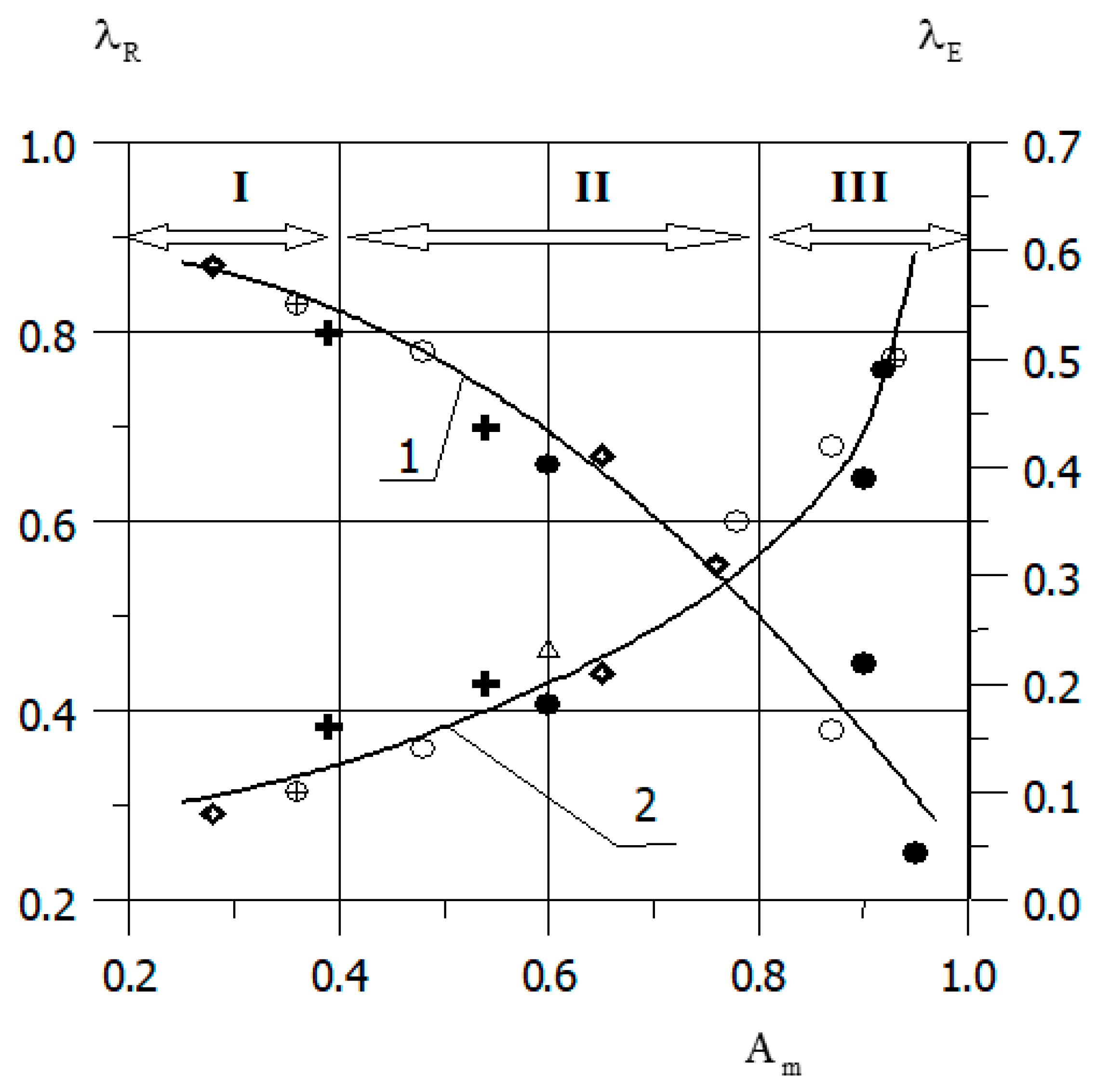
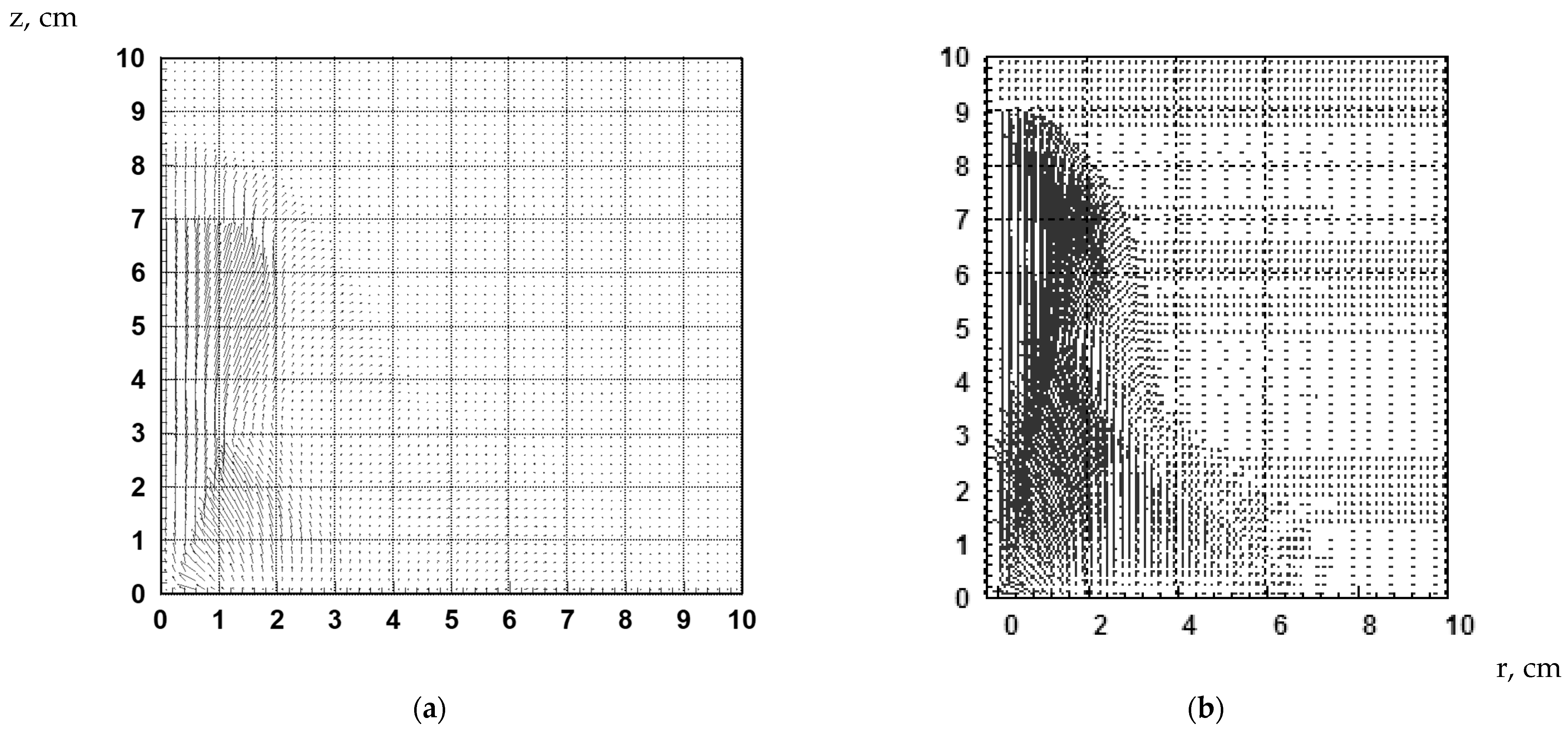


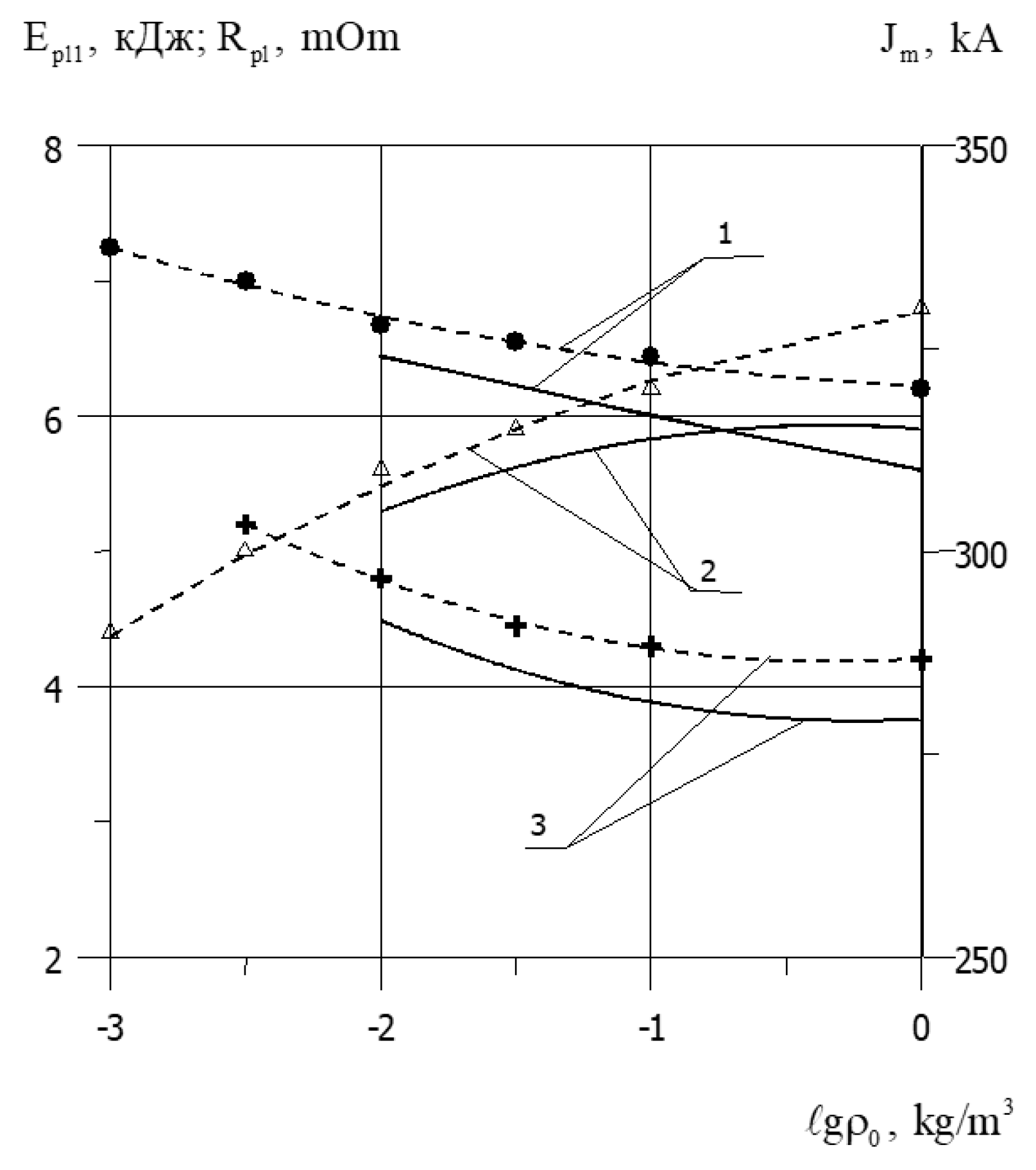
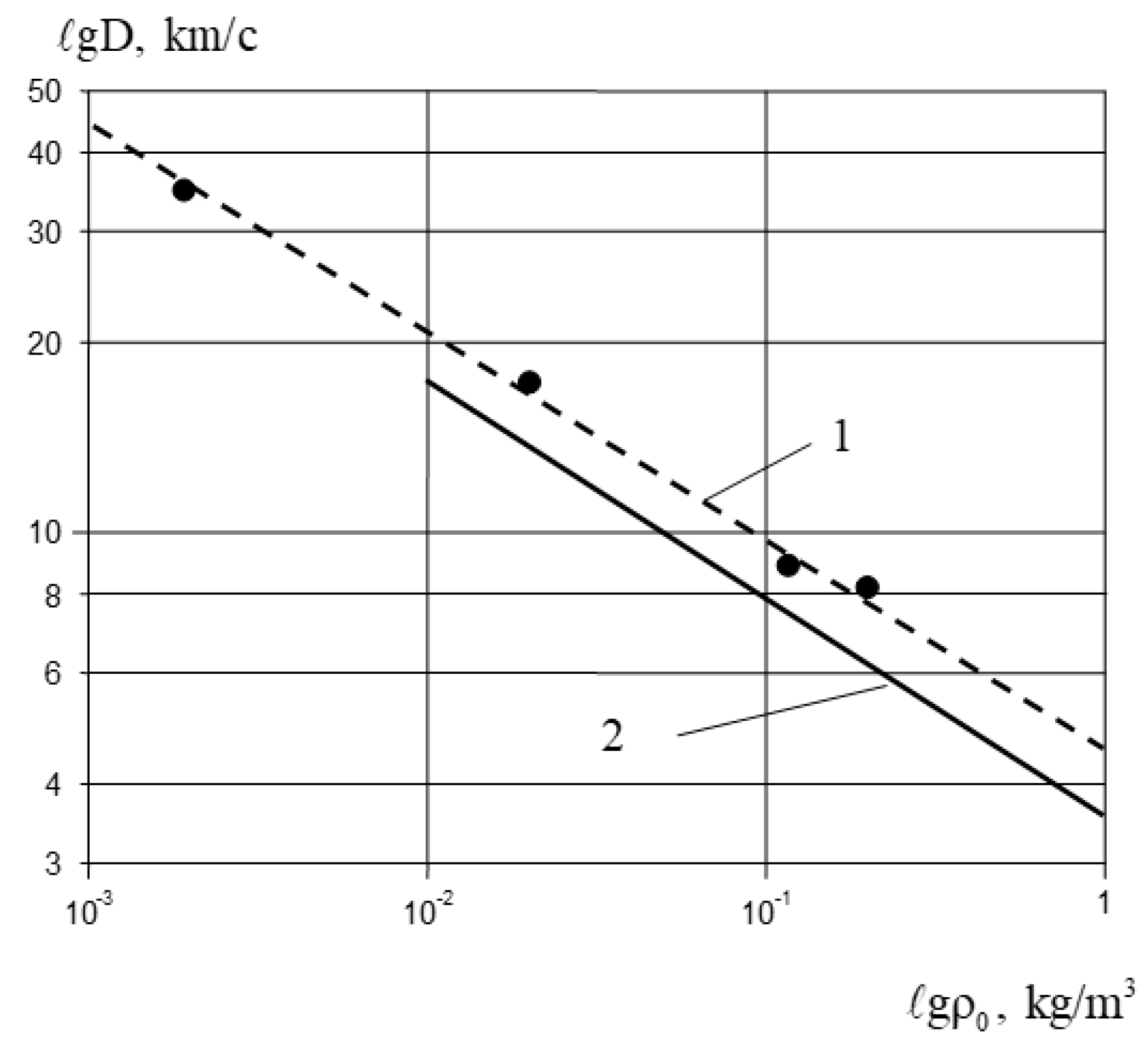
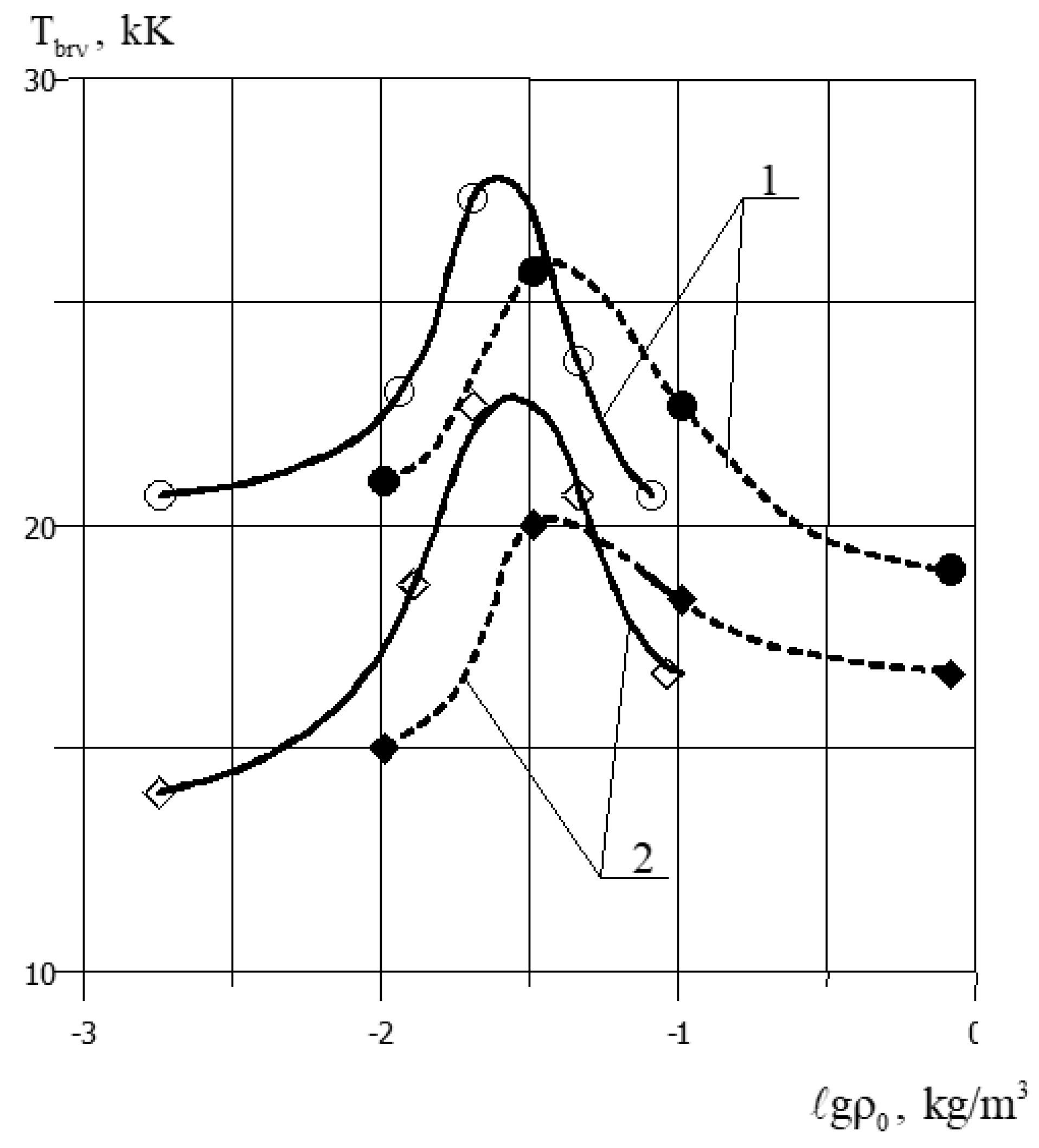
| , MPa | , μF | , kV | , kJ | |
|---|---|---|---|---|
| 10−3 | 28.6 | 10 | 1.43 | 0.6 |
| 30 | 12.9 | 0.9 | ||
| 50 | 35.7 | 0.93 | ||
| 750 | 2 | 1.5 | 0.48 | |
| 5 | 9.37 | 0.78 | ||
| 10 | 37.5 | 0.91 | ||
| 10−2 | 28.6 | 10 | 1.43 | 0.3 |
| 30 | 12.9 | 0.65 | ||
| 50 | 35.7 | 0.76 | ||
| 750 | 5 | 9.37 | 0.6 | |
| 10 | 37.5 | 0.85 | ||
| 10−1 | 28.6 | 30 | 12.9 | 0.36 |
| 200 | 571 | 0.95 | ||
| 750 | 2 | 1.5 | 0.25 | |
| 5 | 9.37 | 0.4 | ||
| 10 | 37.5 | 0.54 |
| Gas | Argon | Air | ||
|---|---|---|---|---|
| Spectral Interval, eV | MPC Parameters | |||
| C = 750 µF, U = 5 kV | C = 750 µF, U = 10 kV | C = 750 µF, U = 10 kV | ||
| P = 10−1 atm, Am = 0.6 | P = 10−2 atm, Am = 0.8 | P = 10−2 atm, Am = 0.85 | P = 10−2 atm, Am = 0.85 | |
| 0.1 ÷ 3.14 | 20 | 20 | 20 | 40 |
| 3.14 ÷ 5.98 | 30 | 20 | 15 | 50 |
| 5.98 ÷ 11.62 | 50 | 40 | 35 | 10 |
| >11.62 | – | 20 | 30 | – |
Disclaimer/Publisher’s Note: The statements, opinions and data contained in all publications are solely those of the individual author(s) and contributor(s) and not of MDPI and/or the editor(s). MDPI and/or the editor(s) disclaim responsibility for any injury to people or property resulting from any ideas, methods, instructions or products referred to in the content. |
© 2023 by the authors. Licensee MDPI, Basel, Switzerland. This article is an open access article distributed under the terms and conditions of the Creative Commons Attribution (CC BY) license (https://creativecommons.org/licenses/by/4.0/).
Share and Cite
Kuzenov, V.V.; Ryzhkov, S.V.; Yu. Varaksin, A. Simulation of Parameters of Plasma Dynamics of a Magneto Plasma Compressor. Appl. Sci. 2023, 13, 5538. https://doi.org/10.3390/app13095538
Kuzenov VV, Ryzhkov SV, Yu. Varaksin A. Simulation of Parameters of Plasma Dynamics of a Magneto Plasma Compressor. Applied Sciences. 2023; 13(9):5538. https://doi.org/10.3390/app13095538
Chicago/Turabian StyleKuzenov, Victor V., Sergei V. Ryzhkov, and Aleksey Yu. Varaksin. 2023. "Simulation of Parameters of Plasma Dynamics of a Magneto Plasma Compressor" Applied Sciences 13, no. 9: 5538. https://doi.org/10.3390/app13095538
APA StyleKuzenov, V. V., Ryzhkov, S. V., & Yu. Varaksin, A. (2023). Simulation of Parameters of Plasma Dynamics of a Magneto Plasma Compressor. Applied Sciences, 13(9), 5538. https://doi.org/10.3390/app13095538






